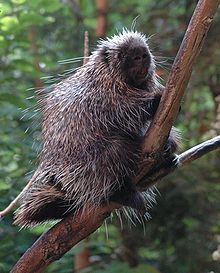porcupine
Appearance
English
[edit]

Alternative forms
[edit]- porpentine, porpintine (archaic alterations of porcupine)
Etymology
[edit]From Middle English porke despyne, from Old French porc-espin, from Latin porcus (“pig”) + spinus (“spine”), hence also spine pig. Cognate with Spanish puercoespín, Italian porcospino, Portuguese porco-espinho.
Pronunciation
[edit]- IPA(key): /ˈpɔː(ɹ)kjʊˌpaɪn/
Audio (Southern England): (file)
- (colloquial) IPA(key): /ˈpɔː(ɹ)kiˌpaɪn/, /ˈpɔː(ɹ)kɪˌpaɪn/, /ˈpɔː(ɹ)kəˌpaɪn/
Noun
[edit]porcupine (plural porcupines)
- Any of several rodents of either of the taxonomic families Hystricidae (Old World porcupines) or Erethizontidae (New World porcupines), both from the infraorder Hystricognathi, noted for their sharp spines or quills, which are raised when the animal is attacked or surprised.
- 1981, Adolph Murie, The Grizzlies of Mount McKinley, page 218:
- I have no evidence of grizzlies killing porcupines or vice versa. However, occasionally there is contact and sometimes a grizzly is injured or a porcupine killed, but the latter is rare.
- 2010, Richard Potts, Early Hominid Activities at Olduvai, page 81:
- In particular, porcupines, hyenas, and leopards are known in Africa to transport bones to particular places.
- 2011, John P. Rafferty, Rats, Bats, and Xenarthrans, page 113:
- Old World porcupines (Hystricidae) have quills embedded in clusters, whereas in New World porcupines (Erethizontidae) single quills are interspersed with bristles, underfur, and hair. No porcupine can throw its quills, but they detach easily and will remain embedded in an attacker.
Synonyms
[edit]Hyponyms
[edit]- (any species of Erethizontidae): porcupette (baby porcupine)
Derived terms
[edit]- African brush-tailed porcupine (Atherurus africanus)
- African crested porcupine
- Andean porcupine (Coendou quichua)
- Bahia porcupine (Sphiggurus insidiosus)
- bicolored-spined porcupine (Coendou bicolor)
- black dwarf porcupine (Coendou nycthemera)
- black-tailed hairy dwarf porcupine (Sphiggurus melanurus)
- Brazilian porcupine (Coendou prehensilis)
- bristle-spined porcupine (Chaetomys subspinosus) ( = bristle-spined rat)
- brown hairy dwarf porcupine (Sphiggurus vestitus)
- Canada porcupine (Erethizon dorsatum)
- Canadian porcupine (Erethizon dorsatum)
- Cape porcupine
- common porcupine (Erethizon dorsatum)
- crested porcupine (Hystrix cristata)
- frosted hairy dwarf porcupine (Sphiggurus pruinosus)
- Koopman's porcupine (Coendou nycthemera)
- Mexican hairy dwarf porcupine (Sphiggurus mexicanus)
- Mexican tree porcupine (Sphiggurus mexicanus)
- New World porcupine (Erethizontidae)
- North American porcupine (Erethizon dorsatum)
- Old World porcupine (Hystricidae)
- orange-spined hairy dwarf porcupine (Sphiggurus villosus)
- Paraguaian hairy dwarf porcupine (Sphiggurus spinosus)
- Porcs
- Porcupine Abyssal Plain (PAP)
- Porcupine Bank
- porcupine caribou (Rangifer tarandus granti) ( = Grant's caribou)
- Porcupine Creek
- porcupine family
- porcupinefish, porcupine fish (Tetraodontidae)
- Porcupine Flat Campground
- porcupine flower (Barleria prionitis)
- Porcupine Freedom Festival (PorcFest)
- Porcupine Gold Rush
- Porcupine Gorge National Park, Queensland, Australia ( = Porcupine Gorge)
- porcupine grass
- Porcupine Hills
- Porcupine Lake
- Porcupine Mall
- Porcupine Meadows Provincial Park, British Columbia, Canada, ( = Porcupine Meadows Park)
- Porcupine Mountains, Michigan ( = Porkies)
- Porcupine Mountains Wilderness State Park
- Porcupine, Ontario
- Porcupine Plain, Saskatchewan
- porcupine puffer
- Porcupine River
- Porcupine Seabight
- Porcupine, South Dakota
- Porcupine, Wisconsin
- prehensile-tailed porcupine (Coendou spp.)
- Roosmalen's dwarf porcupine (Sphiggurus roosmalenorum)
- Rothschild's porcupine (Coendou rothschildi)
- Santa Marta porcupine (Coendou sanctamartae)
- sea porcupine
- South Porcupine, (Ontario) (SoPo)
- streaked dwarf porcupine (Sphiggurus ichillus)
- stump-tailed porcupine (Echinoprocta rufescens)
- thin-spined porcupine (Chaetomys subspinosus) ( = bristle-spined rat)
- USS Porcupine
Related terms
[edit]Translations
[edit]large rodent
|
See also
[edit]Categories:
- English terms inherited from Middle English
- English terms derived from Middle English
- English terms derived from Old French
- English terms derived from Latin
- English 3-syllable words
- English terms with IPA pronunciation
- English terms with audio pronunciation
- English lemmas
- English nouns
- English countable nouns
- English terms with quotations
- en:Caviomorphs
- en:Phiomorphs

